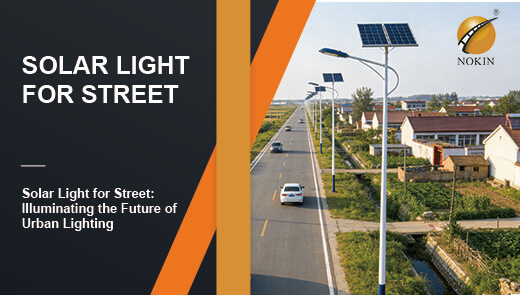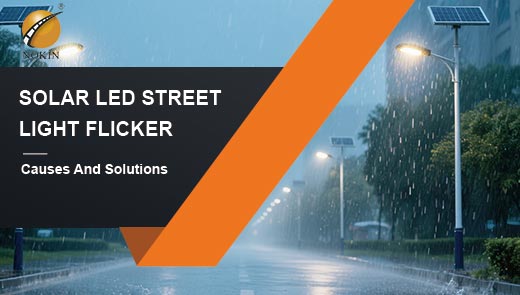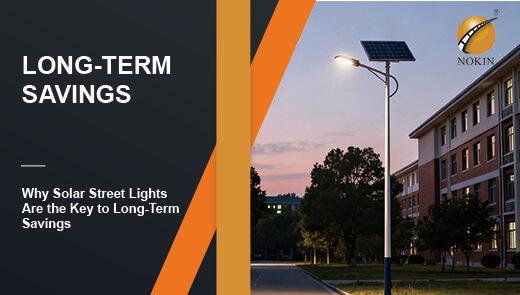8 Misunderstandings You May Have for Solar Street Lights
Although solar street lights have been increasingly applied to all aspects of our lives and work, there are still many people who have many misunderstandings about solar street lights. They have doubts about the performance, cost-effectiveness and reliability of solar street lights, and prefer to believe in traditional grid street lights. Next, Nokin will solve these misunderstandings for you one by one, so that you can have a deeper understanding of real solar street lights.
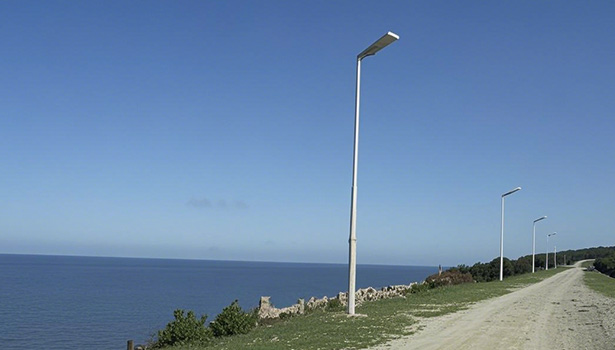
Misunderstanding 1: Solar Street Lights Only Work in Sunny Climates
Common Misunderstandings
The energy of solar street lights comes from sunlight, so many people take it for granted that in some rainy or cloudy areas, solar street lights cannot operate normally. This misunderstanding has also led to many areas always choosing traditional street lights as their lighting equipment. But is this really the case?
Technical Truth
Energy storage upgrade: Solar street light manufacturers introduced that with the continuous upgrading of technology, the conversion efficiency of modern solar panels has been increased to more than 20%. With large-capacity lithium batteries, even if there are 3-5 consecutive days of rainy weather, they can store enough electricity to maintain night lighting.
Regional adaptability breakthrough: Solar lighting systems have developed differentiated solutions. For example, low-temperature batteries designed for high-latitude areas (still working at -40℃), and high-sensitivity photovoltaic panels dedicated to cloudy areas, ensure stable operation in different climates.
Core Technology Support
Wide-temperature battery: Advanced solar street light systems prefer lithium iron phosphate materials, with a temperature range of -40℃ to 70℃, which can adapt to extreme climates.
Self-cleaning photovoltaic panels: The hydrophobic coating on the surface can automatically remove dust and rainwater, maintain a light absorption rate of more than 95%, ensure efficient photoelectric conversion, and provide enough energy for nighttime lighting.
Intelligent energy management: Some solar street lights have built-in intelligent energy management devices, which can dynamically adjust the lighting power according to weather forecasts, optimize energy distribution, and ensure longer lighting.
Misunderstanding 2: Solar Street Lights are Unreliable in Bad Weather
Cognitive Bias
Since most solar street lights are used outdoors, bad weather conditions, such as typhoons, heavy rains, and extreme cold, are often regarded as the "nemesis" of solar street lights. Many people worry that the equipment will frequently fail due to environmental influences.
Actual Performance of Solar Street Lights
Disaster resistance verification: Actual measurement data shows that high-quality solar street light poles can withstand strong winds of 145 miles per hour (about 233 kilometers per hour), which is equivalent to the destructive power of a level 17 typhoon.
Advantages of independent operation: Different from the series connection mode of traditional grid street lights, each solar street light is an independent individual. They use a single point of independent power supply. The failure of a single device does not affect the overall system, avoiding the "black" phenomenon and ensuring night lighting under bad weather conditions.
Technical Guarantee
IP68 protection level: The lamp housing of solar street lights with high protection level is completely dustproof and waterproof, and can work normally in 1 meter deep water.
Intelligent temperature control system: When the internal temperature exceeds 60℃, the solar street light system will automatically start the cooling fan to ensure the stable operation of the electronic components.
Misunderstanding 3: The Brightness of Solar Street Lights is Insufficient
Traditional Cognitive Limitations
Some users believe that the power of solar power supply is limited and it is difficult to meet the brightness requirements of road lighting.
Technological Breakthrough
LED light effect innovation: The new generation of LED chips has a light effect of 130lm/W, which is twice the brightness of traditional high-pressure sodium lamps at the same power. For example, a 50W solar street light can achieve a lighting effect of 6000 lumens and cover an area with a radius of 20 meters.
Optimized optical design: Using lens-type light distribution technology, the light uniformity is increased to more than 0.7 (traditional street lights are about 0.4), avoiding "blind spots".
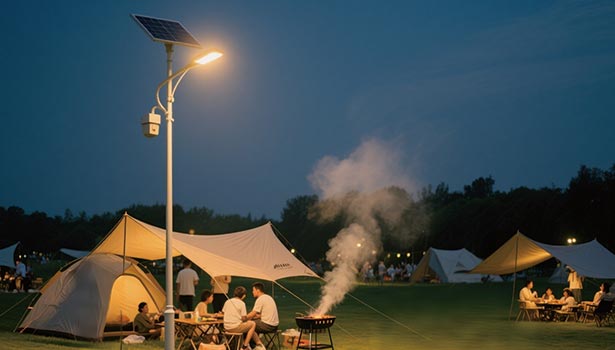
Misunderstanding 4: Solar Street Lights Require Frequent Maintenance
Wrong Assumption
In the early days of solar street lights, their performance did not fully meet people's needs. They often needed to replace batteries and clean equipment frequently, and the maintenance cost was high. However, with the development and progress of technology, today's solar street lights are no longer what they used to be. Their performance has been recognized by the majority of users, and low maintenance requirements have reduced a lot of maintenance costs.
Features of Modern Solar Street Lights
Long-life components:Photovoltaic panels: Up to 25 years of service life, and the attenuation rate is less than 20%. All you need to do is arrange time for regular dust removal and cleaning every year, and increase the frequency appropriately when there is heavy wind and sand in spring or snow in winter.
LED lights: Use the new 3030 high-efficiency lamp beads, up to 50,000 hours of life (10 hours a day for 13 years), and almost no replacement is required.
Lithium batteries: The number of cycle charge and discharge exceeds 3,000 times, and normal use can reach 5-8 years.
Maintenance-free design: Solar street lights are off-grid lighting equipment. They do not require trenching and wiring during installation, and there is no grid connection. This not only eliminates the cable aging and other faults of traditional street lights, but also avoids maintenance pain points such as leakage.
Misunderstanding 5: The Initial Cost of Solar Street Lights is Too High
Cost Perception Bias
When you decide to purchase solar street lighting equipment for your project, if you only focus on the purchase price and ignore the full life cycle cost, it will lead to a misjudgment of the cost performance. It is true that the purchase cost of solar street lights is higher than that of traditional street lights, but in the full life cycle, its low installation cost, low maintenance requirements, zero electricity bills, and long service life make its overall cost lower than that of traditional street lights.
Initial Investment Comparison
Traditional street lights: need to be connected to the power grid, so cable laying and transformer installation are required, and the total initial cost is 30%-50% higher than that of solar street lights.
Solar street lights: After a one-time investment, there is no electricity bill and no cable maintenance costs.
Investment Payback Period
Taking 100 street lights as an example, the solar energy solution will cost an additional 500,000 yuan in the initial stage, but the cost can be recovered through electricity savings within 5-8 years, and the subsequent use time is the pure profit. Therefore, when you calculate the cost, please consider the entire life cycle, not just the purchase cost.
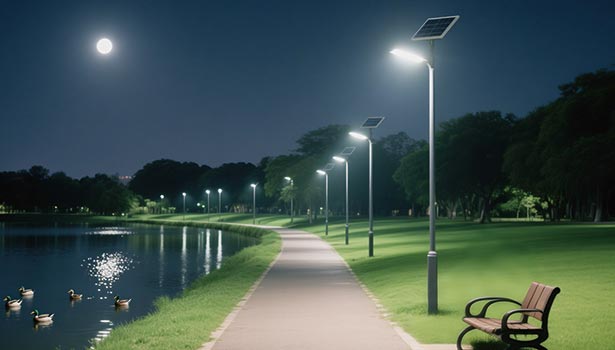
Misunderstanding 6: Same Appearance Means Same Quality
Purchase Misunderstanding
The appearance difference of solar street lights is actually not very large. Some users only judge the quality of the products based on the appearance or frame of the lamps, ignoring the differences in core components.
Internal Differences Revealed
Battery grade differentiation:
A-grade battery: using new lithium iron phosphate material, the capacity decay rate is less than 3% per year, and it has a longer service life.
C-grade battery: recycled battery cell assembly, the capacity may drop by 50% after 1 year, and frequent replacement is required, increasing costs.
Controller technology gap:
MPPT controller: energy conversion efficiency is more than 95%, supports intelligent charge and discharge management, and can effectively extend the use time of solar street lights.
PWM controller: The efficiency is only 70%-80%, which can easily lead to overcharge and overdischarge of the battery, shorten the battery life and increase maintenance costs.
Misunderstanding 7: The Higher the Wattage, the Higher the Brightness
Parameter Cognition Error
When we mention the brightness of lamps, we tend to think that wattage is equivalent to brightness, and often ignore the more core indicator of light efficiency. With the upgrading of lighting technology, the light efficiency of solar street lights has been greatly improved. Even 50W lamps can bring enough brightness.
Correct Purchase Logic
Brightness core indicator: lighting effect is determined by "lumen (lm)". For example:
◦ Poor quality 50W street lamp: light efficiency 80lm/W, total brightness 4000lm
◦ High quality 50W street lamp: light efficiency 130lm/W, total brightness 6500lm (the difference is 62.5%)
Purchase Suggestion
When you purchase solar street lights, you can ask the supplier to provide a light efficiency test report, and give priority to products with light efficiency > 120lm/W.
Misunderstanding 8: Low Price Means High Cost Performance
Market Trap
The solar street light market is mixed, and some inferior products drive down product prices, causing some manufacturers to use inferior materials, such as recycled batteries and inefficient photovoltaic panels, resulting in a vicious cycle of "half-year bad".
Rational Purchasing Strategy for Solar Street Lights
Visit the factory: Investigate the production line on site and give priority to companies with ISO9001 certification.
Test samples: Pass a 2-month aging test to observe the lighting stability under continuous rainy weather.
Check cases: Require installation projects of more than 3 years to verify long-term reliability.
Review warranty: High-quality manufacturers usually provide a warranty of more than 3 years and dare to promise "24-hour response to failures".
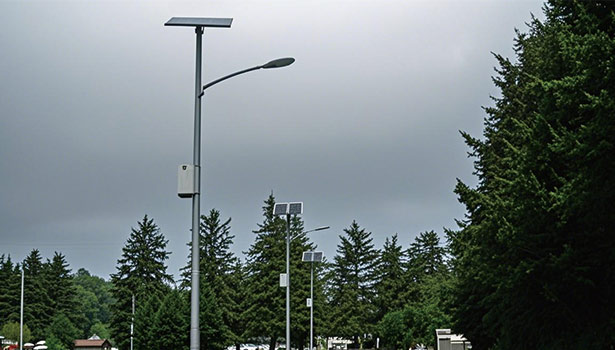
Conclusion
As green lighting equipment that complies with environmental protection and sustainable development, solar street lights have been upgraded from the original forced alternative to the mainstream choice. In countless projects in many countries and regions around the world, their reliability, economy and environmental friendliness have been verified again and again. When you unravel these misunderstandings about solar street lights, you will find that solar street lights, as a reliable, cost-effective, bright lighting device, are worthy of your firm choice!

